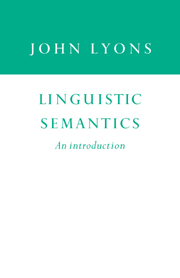Book contents
- Frontmatter
- Contents
- Preface
- List of symbols and typographical conventions
- Part 1 Setting the scene
- Part 2 Lexical meaning
- Part 3 Sentence-meaning
- 5 Meaningful and meaningless sentences
- 6 Sentence-meaning and propositional content
- 7 The formalization of sentence-meaning
- Part 4 Utterance-meaning
- Suggestions for further reading
- Bibliography
- Index
7 - The formalization of sentence-meaning
Published online by Cambridge University Press: 05 June 2012
- Frontmatter
- Contents
- Preface
- List of symbols and typographical conventions
- Part 1 Setting the scene
- Part 2 Lexical meaning
- Part 3 Sentence-meaning
- 5 Meaningful and meaningless sentences
- 6 Sentence-meaning and propositional content
- 7 The formalization of sentence-meaning
- Part 4 Utterance-meaning
- Suggestions for further reading
- Bibliography
- Index
Summary
INTRODUCTION
This chapter follows on from the preceding one and looks at two historically important and highly influential theories of sentence-meaning which, since the mid-1960s, have been associated with the attempt to formalize the semantic structure of languages within the framework of Chomskyan and non-Chomskyan generative grammar.
The first is the Katz–Fodor theory of meaning, which originated in association with what we may now think of as the classical version of Chomsky's theory of transformational-generative grammar. The second theory is a particular version of possible-worlds semantics, initiated also in the late 1960s by Richard Montague, and, having been further developed by his followers, is now widely recognized as one of the most promising approaches to the truly formidable task of accounting for the propositional content of sentences in a mathematically precise and elegant manner.
The treatment of both theories is very selective and almost completely non-technical. I have been more concerned to explain some of the basic concepts than to introduce any of the formalism. At the same time, it must be emphasized that modern formal semantics is a technical subject, which cannot be understood without also understanding the mathematical concepts and notation that are a part of it. This chapter should definitely be read in conjunction with the more specialized introductions to formal semantics mentioned in the ‘Suggestions for further reading’.
- Type
- Chapter
- Information
- Linguistic SemanticsAn Introduction, pp. 199 - 233Publisher: Cambridge University PressPrint publication year: 1995



